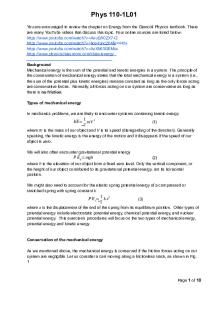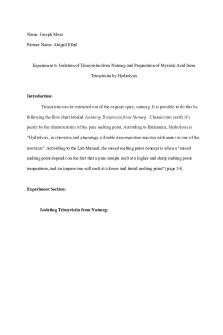Lab Report 5 PDF

| Title | Lab Report 5 |
|---|---|
| Course | Veterinary Parasitology |
| Institution | University of Massachusetts Amherst |
| Pages | 6 |
| File Size | 400 KB |
| File Type | |
| Total Downloads | 76 |
| Total Views | 145 |
Summary
Lab Report...
Description
L3 Lab Report 5: Nematodes and Fecal Testing Cont. Fecal Testing Continued 1. Each student will run each of the following Fecal Flotation Procedures: a. Fecalyzer Animal Signalment: Roxy, Canine, Mastiff, DOB: 4/24/18, owner: Jane Stewart Gross Exam: Normal color, no visible parasites, no blood, no mucous, no foreign material, normal consistency score= 4 Steps for test: 1. Lift cap but leave the green insert in the clear tube. Insert the stool sample into the small end of the insert. 2. Fill the green insert with a flotation solution half way. Rotate the green insert in the clear tube but twisting back and forth, allowing the ova to separate from the fecal sample. 3. Push the green insert firmly in place with a tongue depressor or thumbs. Fill the rest of the insert and form a meniscus. 4. Place a cover slip on the meniscus for 15-20 minutes. Apply cover slip to a fresh slide. 5. Examine the slide under 10x. Result: Negative b. Ovatector Animal Signalment: Sybil, Canine, Unknown breed, DOB: unknown, sample collected 9/20/18, owner: Lindsey Marthy, #2302983850 Gross Exam: Normal color, no visible parasites, no blood, no mucous, no foreign material, normal consistency score= 5 Steps for test: 1. Remove spatula from device and collect fecal sample into the center receptacle. Return the clear tube atop the center receptacle. 2. Fill tube half way with a flotation solution. Mix fecal sample with flotation solution and push down gently with the strainer. 3. Fill the rest of the tube with the flotation solution and form a meniscus. 4. Place a cover slip over the meniscus and let sit for 15 minutes, to allow the ova to float through the strainer up to the slip. 5. Apply cover slip to a slide and examine under 10x. Results: Negative
Nematode Slides: Examine all slides below and sketch your findings. 1. Ancylostoma caninum adult (female) Common name: Hookworm
Sketch
https://en.wikipedia.org/wiki/Ancylostoma_caninum
2. Necator americanus ova Common name: human hookworm- similar to SA hookworm
https://helminthictherapywiki.org/wiki/index.php/Gallery
3. Trichuris Female Adult Common name: Whipworm
Sketch
rm-
trichuris-trichiura/
4. Trichuris ova Common name: Whipworm Height: 30 microns – Length: 50 microns
Sketch
html
5. Ascaris ova large animal roundworm Height: 50 microns – Length: 60 microns
Sketch
https://en.wikipedia.org/wiki/Ascaris_lumbricoides
6. Toxocara canis ova Canine Roundworm
Sketch
https://web.stanford.edu/group/parasites/ParaSites2005/Toxocariasis/whole%20thing.htm
Genus name: Tocascaris leonine – Common name: Roundworm
https://en.wikipedia.org/wiki/Toxascaris_leonina Genus name: Baylisascaris procyoncis – Common name: Raccoon roundworm
https://www.cdc.gov/dpdx/baylisascariasis/index.html 7. Acanthocephala adult Common name: Thorny headed worms
Sketch
http://www2.biology.ualberta.ca/parasites/ParPub/text/text/acant01b.htm
8. Acanthocephalan ova Common name: Thorny headed worm
Sketch logy-
7925344
9. Haemonchus contortus Common name: Barber pole worm
Sketch
http://www.wormboss.com.au/worms/roundworms/barbers-pole-worm.php
10. Oesophagostomum radiatum Common name: Nodular worm
Sketch
http://parasitesworld.com/oesophagostomum-radiatum-3/ 11. Trichinella in muscle tissue Common name: The Pork worm
Sketch
https://www.cdc.gov/dpdx/trichinellosis/index.html
3.Scan the Strongyloides wet mount. Draw and include image.
Sketch
http://www.phsource.us/PH/HELM/PH_Parasites/Strongyloidiasis.htm 4. Baermann technique. a. What is the Baermann technique most commonly used for? The Baermann technique is most commonly used for lungworm in felines and threadworm in canines. https://www.plantpath.iastate.edu/tylkalab/content/extractingnematodes-soil-baermann-funnel ...
Similar Free PDFs

LAB 5 - Lab report
- 4 Pages

Lab Report 5 - lab
- 5 Pages

Lab 5 - Lab report
- 6 Pages

Lab 5 - Lab experiment report
- 6 Pages

Lab 5 Lab Report- (Microbiology)
- 4 Pages

Phys lab 5 - Lab report
- 10 Pages

Experiment 5 - Lab Report 5
- 16 Pages

Post Lab Report Lab 5
- 5 Pages

Lab 5 Report
- 5 Pages

Chem lab report 5
- 7 Pages

Lab 5 Report
- 8 Pages

EX 5 lab report
- 10 Pages

Lab Report 5
- 8 Pages

Lab Report 5
- 16 Pages

Lab report 5
- 13 Pages

Lab Report 5
- 6 Pages
Popular Institutions
- Tinajero National High School - Annex
- Politeknik Caltex Riau
- Yokohama City University
- SGT University
- University of Al-Qadisiyah
- Divine Word College of Vigan
- Techniek College Rotterdam
- Universidade de Santiago
- Universiti Teknologi MARA Cawangan Johor Kampus Pasir Gudang
- Poltekkes Kemenkes Yogyakarta
- Baguio City National High School
- Colegio san marcos
- preparatoria uno
- Centro de Bachillerato Tecnológico Industrial y de Servicios No. 107
- Dalian Maritime University
- Quang Trung Secondary School
- Colegio Tecnológico en Informática
- Corporación Regional de Educación Superior
- Grupo CEDVA
- Dar Al Uloom University
- Centro de Estudios Preuniversitarios de la Universidad Nacional de Ingeniería
- 上智大学
- Aakash International School, Nuna Majara
- San Felipe Neri Catholic School
- Kang Chiao International School - New Taipei City
- Misamis Occidental National High School
- Institución Educativa Escuela Normal Juan Ladrilleros
- Kolehiyo ng Pantukan
- Batanes State College
- Instituto Continental
- Sekolah Menengah Kejuruan Kesehatan Kaltara (Tarakan)
- Colegio de La Inmaculada Concepcion - Cebu